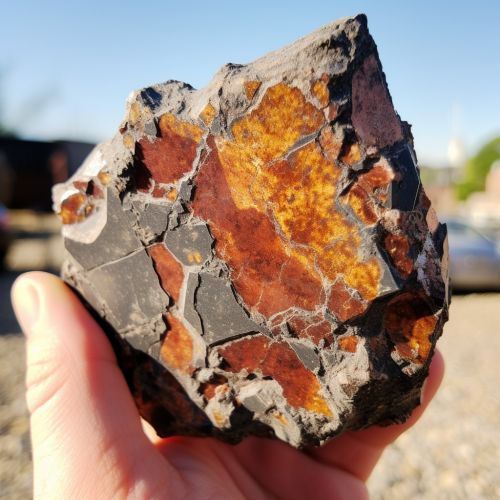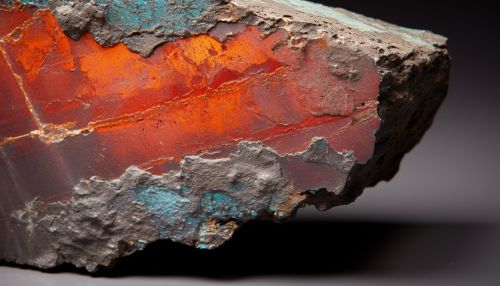Impactite
Introduction
Impactites are geological materials that have been significantly altered or formed as a result of the high pressure and high temperature conditions during a meteorite impact event. These materials, which can include shock-metamorphosed rocks, melt rocks, and mixtures of these, provide important evidence for understanding the history and dynamics of meteor impacts on Earth and other planetary bodies.


Formation
Impactites are formed during the intense conditions of a meteorite impact. When a meteorite strikes a planetary surface, it releases a tremendous amount of energy, creating conditions of extreme temperature and pressure. This energy can melt, vaporize, or otherwise alter the target rocks, resulting in the formation of impactites.
The formation process of impactites involves several stages. Initially, the impact generates a shock wave that propagates through the target rocks, causing shock metamorphism. This can result in the formation of planar deformation features (PDFs) in minerals, the formation of high-pressure mineral phases, and other changes in the rock's structure and composition.
Following the shock stage, the energy of the impact can cause melting of the target rocks, leading to the formation of impact melt rocks. These rocks solidify from a molten state and can contain evidence of the high-pressure conditions during their formation, such as shock-induced vitrification and the presence of high-pressure mineral phases.
In some cases, the impact can also produce a mixture of shock-metamorphosed and melt rocks, known as suevite. This rock type is characterized by the presence of clasts of shock-metamorphosed rocks within a matrix of impact melt rock.
Classification
Impactites can be classified based on their composition, structure, and the degree of shock metamorphism and melting they have undergone. This classification is important for understanding the conditions during the impact event and the nature of the target rocks.
Shock-metamorphosed rocks are classified based on the presence and intensity of shock metamorphic features. These can include shatter cones, PDFs, and high-pressure mineral phases. The degree of shock metamorphism can provide information about the pressure conditions during the impact.
Impact melt rocks are classified based on their composition and the presence of evidence for melting. This can include the presence of vitrified materials, glassy matrices, and high-pressure mineral phases. The composition of the melt rocks can provide information about the composition of the target rocks and the temperature conditions during the impact.
Suevite is a specific type of impactite that is characterized by the presence of clasts of shock-metamorphosed rocks within a matrix of impact melt rock. The proportion and nature of the clasts and matrix can provide information about the dynamics of the impact event and the nature of the target rocks.
Distribution
Impactites are found at meteorite impact sites around the world. These sites can range in age from the recent past to billions of years old, and can provide important information about the history of meteorite impacts on Earth.
Some of the most well-known sites where impactites are found include the Chicxulub crater in Mexico, the Sudbury Basin in Canada, and the Vredefort crater in South Africa. These sites are associated with some of the largest known meteorite impacts on Earth, and have produced a wide variety of impactites, including shock-metamorphosed rocks, melt rocks, and suevite.
In addition to these sites, impactites can also be found in smaller impact craters and in the geological record as tektites and microtektites, which are small glassy objects that are thought to be formed during meteorite impacts.
Importance
Impactites are of significant scientific interest because they provide direct evidence for meteorite impacts and can provide information about the conditions during these events. This can include information about the energy of the impact, the nature of the target rocks, and the dynamics of the impact process.
In addition, impactites can provide important information about the history of meteorite impacts on Earth and other planetary bodies. This can include information about the frequency and size of past impacts, as well as their effects on the geological and biological history of the planet.
Impactites are also of interest for their potential economic value. Some impactites, such as the Sudbury Igneous Complex, are associated with significant mineral deposits, including nickel, copper, and platinum group elements. These deposits are thought to be formed by the concentration of these elements during the impact event and the subsequent geological processes.
